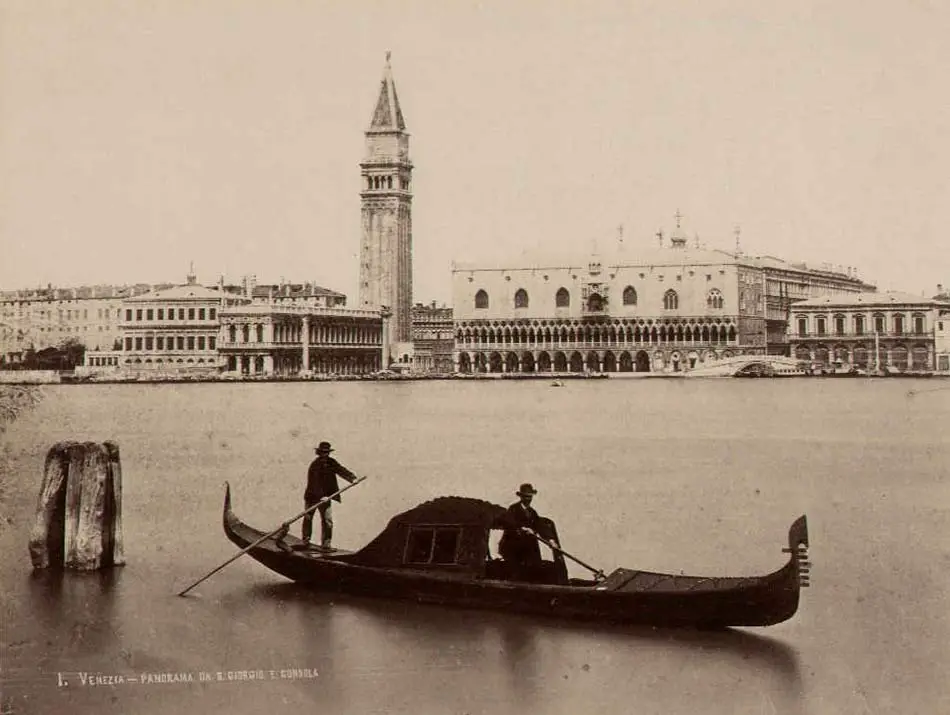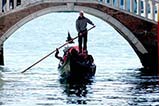
Gondola of Venice - Venice and its lagoon
(Photo: Gondola con felze, Carlo Naya (1816-1882)
The gondola is the typical boat of Venice that - until the advent of motor boats - was the most suitable and common means to move between the winding canals of the historic center of Venice.
Its name derives from the medieval Greek κονδοῦρα, a type of boat typical of the Upper Adriatic - similar to the sandolo or mascareta that can be appreciated in some paintings by Carpaccio and Bellini - and in use in Venice at least since the early Middle Ages.
Once smaller in size, the shape of the gondola changed with time, becoming slimmer and longer, rising on the stern, and distinguishing itself by the decoration that gave luster to the patrician houses of the city. These often relaxed with the so-called freschi, evening gondola rides through the city canals, often accompanied by music.
Nowadays the ancient custom is destined to tourists who - for a not always modest amount - can enter the canals of the historical center or in the lagoon for a romantic city tour, even accompanied by music and songs; moving in oars as the whole population of Venice once did and the patricians, who in each house kept a gondola moored and had a gondolier de casada.
Technical characteristics of the Venice gondola
Today's gondola has an asymmetrical structure (called a quarter moon) - because it is built with the left side wider than the right one of 24 cm - to favor propulsion to a single oarsman. The hull is elegant and slender and presents the bow and stern raised above the center where the space for passengers develops and below, a flat-bottomed hull, ideal for sailing in shallow waters such as those of salt marshes and mudflats lagoon.
The gondola is made of wood; there are 295 pieces, which collect 8 different wood qualities, which are assembled into a squero by the ax master in about 1 year's time. The oar is made of beech wood while the forcola is made of walnut wood.
Length from 10.80 to 11 m
Width from 1.40 to 1.60 m
Hull weight 350 kg
Number of pieces: 295
Materials: wooden hull, gold and stucco decorations.
Types of wood: elm, walnut, oak, fir, larch, cherry, linden, mahogany. The elm is used for the ribs of the structure.
Walnut being ductile is used for frames; after being wet it is heated with fire and given the desired shape.
The oak being very hard is used for the sides that are the part most exposed to the blows during navigation.
The fir is used for the bottom because - being light - it favors the hydrodynamics of the gondola.
Larch is used because it is very resistant to water.
The cherry is used in the trasti because it is a pressure resistant wood being very hard. The transto is that wood that joins the two bands in the bow where you put your foot to get on the boat.
The linden is used to build the sucket, that is the place of the stern which is the most used one.
Finally, mahogany gives the structure a certain homogeneity by fixing the other woods.
Squeri, carpenters or squeraroli
The place dedicated to the construction of the gondola has always been the squero, a city construction site characterized by overlooking the canal and down to the water for boats. Once there were hundreds in the city but currently only two remain in the historic center of Venice: the Squero Tramontin and the Squero San Trovaso. Then there are the Squero Bonaldi in Ognissanti, the Squero Dei Rossi and the Squero Crea in Giudecca.
History of the Gondola of Venice
The gondola appeared in historical documents only around the 10th century AD but its name declares an older origin.
???d???a in medieval Greek was used to define a kind of boat typical of the Upper Adriatic - similar to sandolo or mascareta that can be appreciated in some paintings by Bellini - and in use in Venice at least since the early Middle Ages.
In short, the ???d???a was similar to the current gondola but shorter and lower, and without the typical asymmetric of the modern gondola. The bottom was low and flat in order to better navigate in the low channels of the salt marshes of the Venetian lagoon.
And this brings back to a much older document that testifies to the navigational abilities of the Venetiani, that is to say of those populations, which, following the Visigoths (401) and above all the Huns of Attila (452), separated from the Eneti of the hinterland to start living on small islets of the lagoon building piles. Here they moved for centuries on small boats of which there is no evidence but which certainly were - for functional reasons - very similar to the ancient ???d???a.
This is the document written in AD 537 from Flavius Magnus Aurelius Cassiodorus, Praetorian Prefect of King Ostrogoto Vitige, to the Venetian Maritime Tribunes, in which the Senator asks the intervention of the Venetian fleet to bring the rich annual production of wine to Istria - capital of the Empire oil.
"...ubi alternus aestus egrediens modo claudit, modo aperit faciem reciproca inundatione camporum. Hic vobis aquatilium avium more domus est."
"where the alternating tide that now advances closes, now opens the appearance of the fields with a flood that comes and goes.
Here is your home similar to water birds. "
"Proinde naves, quas more animalium vestris parietibus illigatis, diligenti cura reficite"
"So the ships, which in the manner of the animals you keep tied to the walls, carefully refurbish diligently."
From this letter it is deduced that the populations were already organized for a maritime commercial activity through the hire and the hiring of crews regulated by the Maritime Tribunes.
Cassiodoro also reports how the Venetians were already dedicated to the production and trade of salt, which at the time was still a currency of exchange throughout the Mediterranean, and had built their houses on the islets of the lagoon enough to appear in the water or on land according to the movement of the tide, and to keep the boats tied like animals outside the home.
In short, flat-bottomed lagoon boats were already in use starting from the 6th century AD and Cassiodorus in the letter speaks of earlier centuries in which the lagoon was already frequented by populations now devoted to fishing. But there is no written or archaeological testimony of earlier times.
From there the gondola, or its antecedent, crossed the centuries of the Serenissima without leaving a trace until its appearance in a document of 1013 which mentions Gondulam true nullam nulli giving defuerit sine libera vestra voluntate that is "Certainly no gondola will be lacking to give to someone without your sincere will".
And then came the years of the splendor of the Serenissima which are shown in the paintings of great painters such as Vittore Carpaccio as Miracle of the Cross in Rialto (1496) or the Miracle of the Cross fallen in the canal of San Lorenzo by Gentile Bellini (1500), once in the Scuola Grande di San Giovanni Evangelista and today in the Gallerie dell'Accademia. From these canvases we can well see the physiognomy of the patrician boats of the time: less slender and shorter and lower, the less curved and simpler fork, the bow and stern irons as simple metal rods. But the f�lze was already present, that is the roof in the center that offered intimacy to the patricians and shelter from the bad weather that - especially in winter - accompanied every gondola trip especially at night.
And therefore only in 1600 did the gondola take on its current appearance, lengthening and creating the most advantageous raised area for the rowing of the gondolier in the stern. The bow also rose, acquiring the ornamental apparatus we know today, which was also distributed along the whole hull, creating a boat both externally and internally that became a message of the opulence of the patrician house that owned it. To decorate the patrician gondolas the best artists of the city were called and only an edict of the Senate of the Republic (8 October 1562) stopped this competition of exhibition of wealth by establishing more sober canons for the decoration of the gondolas; an edict actually hardly heard if it had to be replicated in 1584 and definitively sanctioned only with the end of the plague of 1630, which sanctioned the uniformity of the color of the modern gondola, which had to be black without exception, to moderate the phenomenon of ostentation was created and in respect of a mourning citizen who had already counted 140,000 deaths, or a third of the population.
Curiously even the gondoliers gathered in the guild and had a statute or mari�gola, exactly as it happened for the Schools of Arts and Crafts and the Scuole Grandi of Venice.
The gondola as we see it today - with elaborate stern and bow irons, and with the place of the raised stern - already appears in the eighteenth century paintings of Canaletto as The Grand Canal from the Rialto Bridge towards Ca' Foscari (1728) or The Grand Canal looking north-east from Palazzo Balbi (1724).
The current appearance of the gondola was definitively taken towards the nineteenth century; but space will remain for many innovations in the construction of the boats, which were often introduced by the Squero Tramontin & Figli in the last 130 years.
Gondola ride rates
After many years of unofficial tariffs and prices that have created an unattractive reputation for gondoliers, signs with official tariffs have finally appeared for a few years:
- Tour fare per day: � 80 for 30 minutes; � 40 for every 20 minutes more.
- Evening tour fee: � 100 for 30 minutes; � 50 � for every 20 minutes more.
- Music supplement price: depends on the number of musicians and singers. Usually for � 50 you can hire a singer.
Each gondola can accommodate a maximum of 6 people.
Stazi of gondolas in Venice
To book or leave directly - depending on the availability of boats - for a gondola ride, you can go to the main stazi (Gondola Station) of the city:
Stazio di San Tomà:
in San Tom� in the San Polo district, along the Grand Canal, next to the vaporetto stop of the same name, lines 1 and 2.
Stazio dell'Accademia: in front of the Galleries and the Accademia Bridge, along the Grand Canal, next to the vaporetto stop of the same line 1 and 2.
Stazio di Santa Maria del Giglio:
200 m from Piazza San Marco in front of the Church of San Mois�.
Stazio di Bacino Orseolo a San Marco:
from Piazza San Marco with your back to the Basilica, turn right at the end of the square on Calle Salvadago.
Stazio di Bacino San Marco Danieli:
in front of the famous Hotel Danieli. San Zaccaria stop of the vaporetto line 1 and 2.
Stazione Dogana Ca' Vallaresso:
in San Marco, in front of Punta della Dogana and next to the Gardens. Line 1 vaporetto stop of the same name.
Then there are, scattered around Venice, small moorings for one or two gondolas at most, like the one in front of the Basilica dei Frari. |
 Gondola Ride Tours - Grand Canal and other canals in the centre of Venice
Gondola Ride Tours - Grand Canal and other canals in the centre of Venice